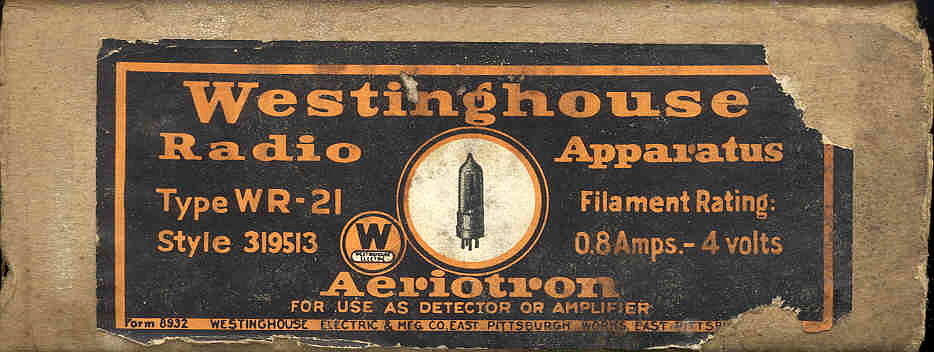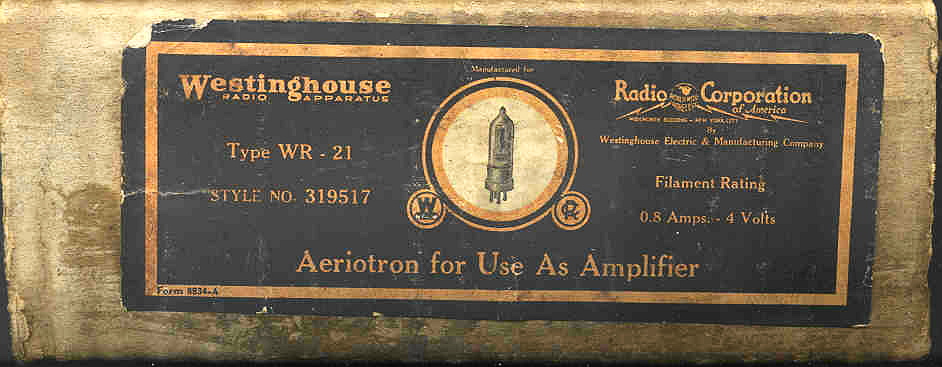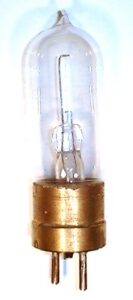George Westinghouse, (1846-1914), industrialist extraordinaire, had the business acumen to start many business ventures that changed people’s lives. In 1884 he formed the Westinghouse Electric and Manufacturing Company, later to be known as the Westinghouse Electric Company. This article will concentrate on the vacuum tube division of W. E. & M and its subsidiary, Westinghouse Lamp Company, and General Electric Company.
First of all, when the US entered WW1, the transatlantic radio station at Brunswick, New Jersey was taken over by the US Navy. This station was owned by the Marconi Wireless Telegraph Company of America and controlled by the British Marconi Company, a foreign company. General Electric made the station equipped 50- kilowatt Alexanderson alternator but the Navy wanted a 200-kilowatt alternator that was nearing completion at the G.E. plant. Marconi refused to bear the coat so G. E. paid for the replacement with the idea in mind to have the only reliable transoceanic communication system in the years 1918-1920. At this time, the station was returned to Marconi. In 1919, Marconi wanted to order 24 Alexanderson alternators from G.E., 14 for American Marconi and 10 for British Marconi along with their exclusive rights to for their use. A report by G. E. to the US Navy of this pending transaction was reviewed. The US Navy concluded that such a sale would be a communication monopoly owned by a foreign entity. This same Navy review board convinced G. E. to form a US company, run by US citizens as a matter of national security. This was done and the new company would be called RCA. RCA had no manufacturing facilities of its own but would be dependent on G. E., Westinghouse Electric & Manufacturing Company, and its subsidiary Company, Westinghouse Lamp Company, also Western Electric and AT&T, to supply them with communication devices. G. E. had been working for years on this new form of technology, the vacuum tube, to replace the very bulky and extremely expensive Alexanderson alternator, used by Marconi. A licensing agreement was signed with Westinghouse Electric & Manufacturing Company on June 30th, 1921
This now brings us to the Westinghouse Electric & Manufacturing along with Westinghouse Lamp Company, that supplied tubes to the newly formed RCA. On January, 1922, the first WD-11 tubes were received by RCA followed by the WR 21 tubes in February and the third shipment of UV 201 tubes arrived in April, 1922. However, the UV 201 tubes supplied by W E & M did not match in appearance or specifications to the UV 201 tubes supplied by Westinghouse Lamp Company or even G. E for that matter.
Click on the pictures below for a larger view.



Fig. 1 The Westinghouse E & M Radiotron UV 201 and box are shown with the early RCA logo in a circled RC. Notice the specs! Fil. Volt. at 4.0, Fil. Amp at 0.8, and the Plate Volt at 20-100. Also notice the black inked rectangular box containing the words “Westinghouse Electric & Mfg. Co.” On the opposite side it states (not shown) “Radiotron, Model UV 201, Patented, Made for Amateur or Experimental Use.” The UV 201 has a Shaw standard 4 pin base that would fit all radio sockets. Most, if not all, Shaw bases on the W E & M,s were purchased from the left- over stock of the Moorhead Company, that went out of business, so they ground off the Marconi and DeForest logos and wording but enough remains to confirm that that is the case.
Fig. 2 The picture in fig. 2 is the Westinghouse Lamp Company version of the UV 201. It has a different bulb shape and the specs are not the same as in fig. 1. They are: Fil. Volt at 5, Fil. Amp at 1 with the Plate Volt being the same at 20- 100. This would mean that the tubes in fig. 1 & 2 would not be inter-changeable. The RC logo in a circle is the same as in fig. 1 and states made for Radio Corporation of America. Wording in black ink is much the same except for the words “Westinghouse Lamp Co. USA.”
Fig. 3 General Electric made their own version of the UV 201 and box as well that can be seen in fig. 3. A look at the specs will confirm that, Fil. Volt at 5, Fil. Amp at 1 and plate Volt at 20-100 is the same as in Fig. 2 but again, it would not be compatible with tube in fig. 1. Inked wording is much the same but unless worn off, it never stated made by G. E. The RC in a circle is the same but this box has the added GE in a circle logo as well.

So, if the specs in fig. 1 do not match the specs in figs. 2, and 3, then what was the W E & M UV 201 made for? Tyne states in the Saga that between April and Sept. 1922, that around 3200 of the UV 201 tubes were made and then the production ceased. He does not say why but only that they stopped making them. Why did they stop and why did they start to make them with the specs they did? It can now only be speculated about now.
The W E & M WD-11 tube is shown in fig. 4 to the left with the production number 319533. These type tubes were made to a very specific set of specs. Filament Volt as 1.1 and filament amps at 0.25. It can be concluded that their UV 201 was not to fill that need. Besides, the standard Shaw base on the UV 201 would not allow to fit into the WD-11 sockets that were made for the RCA radio they were meant for.
Several of the Moorhead tubes had similar specs so did they make the UV 201 to fill that need when Moorhead stopped making their tubes? It seems that the need to fill the gap with the Moorhead tubes had passed several years before and would not make sense at the time they were made. Here is a list of the Moorhead tubes specs: MSN The excess amount of near compatible Moorhead tubes reached into 1925 so it is doubtful the W E & M tubes were made to fill that gap?
Specs for the W E & M WD-11:


To the left is the W E & M WR21 and has quite similar specs to the UV 201, but they are not interchangeable because the pin configuration of the UV 201 would not fit into the socket of the WR 21 in the radio it was meant to serve. I suppose it is possible that the UV 201 tubes were re-based versions of the WR 21, but why would this be necessary, and if this was done, why label the shipping boxes UV 201 instead of WR 21? This is the mystery! Here is a picture of the WR 21 box via Bob here: F10 Also the WR 21 A box, via Bob, here: F11 Notice the different production numbers of link F10, and F11. Also the WB-800 ballast tube, via Bob, for the Aeriola Grand Radio here: F800
Specs for the W E & M WR 21:




Here is a picture of the WR 21 box via Bob, fig. 6. Also the WR 21 A box, via Bob, fig. 7. Notice the different production numbers of link fig. 6, and fig. 7. Also the WB-800 ballast tube, via Bob, for the Aeriola Grand Radio, fig. 8.
Figs. 9-12 are more examples from Bob. Click each picture for a larger view.
Fig. 9 is the early WD 11 without a style number or marked WD 11.
Fig. 10 is an Aeriotron WR 21 A that was in the box in fig. 7 with both having the same production number.
Figs. 11, and 12 are 2 versions of the WB 800 ballast tubes. They have a 2 pin base to fit only into the correct spot.
In conclusion, a few possibilities exist here considering that the W E & M WD-11, and WR 21 tubes were made several months before the UV 201 and were made for very specific RCA radios, all in 1922. RCA 5 page catalog with hook-up instructions for the W E & M Aeriola Grand here: B1
1. Although Tyne states on page 310 of the “Saga” that the W E & M UV 201 is not interchangeable with the Westinghouse Lamp Co. UV 201 or the G.E. UV 201, prominent collector Jim Cross, in a conversation with him, thinks W E & M had the un-based 3200 or so leftover UV 201’s so they just labeled them UV 201 and sold them to zero their stock and add them to the demand for UV 201’s in general. It is not certain that the W E & M tubes would have performed as well as their Lamp Co. or G.E company counterparts. His opinion has great merit as the Aeriola Grand radio was only made for a short time when it was dropped from the RCA line-up, thusly making it quite rare. How did W E & M recover the expense in the making of the 3200 or so UV 201 tubes, or did they just take the loss? Jim also mentioned that many early radios were 1 tube units and the makers could easily adapt the UV 201’s to suit their needs. Jim,s opinions may be what they did?
2. I also received a good deal of information from the collector called “Oldtubes”(Bob). He mentions that the Eric Wenass book “Radiola” states some W E & M DR (early resistance-coupled) version of the later DA (transformer-coupled) version used the UV 201 in an unknown amount. Some RC units were made with a standard socket to fit the UV 201 in a unknown amount. He also states that the WR 21’s were re-based to a standard Shaw base to use their numbers up. A foot-note in the Radiola book refers to the Alan Douglas book “Radio Manufacturers of the 20’s” in which a picture of a DA unit, to be used with an RA unit, seems to show standard socket tubes, possibly UV 201 tubes in that unit.



Fig. 13 shows Bobs W E & M’s Aerioton UV 201 base marked with their production number 319561. This seems to be an earlier version of my W E & M UV 201 shown in fig. 1 that is marked Radiotron and is not marked with the production number. Another look at the UV 201 Bob provided here: UV 201
Fig. 14 is what appears to be a very odd W E & M WD 12 with a WD 11 pin configuration. Could be a prototype or regular production tube that cannot be explained, with a higher production number of 365202.
Fig. 15 shows the more familiar W E & M Radiotron WD 12 with the later version standard UV base but it has retained the same production number as in fig. 14.
Sources:
Tyne, Gerald, “Saga of the Vacuum Tube”, 1977
Cross, Jim, conversation on groups.io regarding the W E & M UV 201 tube. Full credit to Jim for his opinion.
“Oldtubes” (Bob), conversation on groups.io regarding the W E & M line-up of tubes and the UV 201. Full credit to Oldtubes.
Wenass, Eric, “Radiola: The Golden Age of RCA” pages 97-99.
Douglas, Alan, “Radio Manufacturers of the 20’s”, page IX.






Leave a Reply